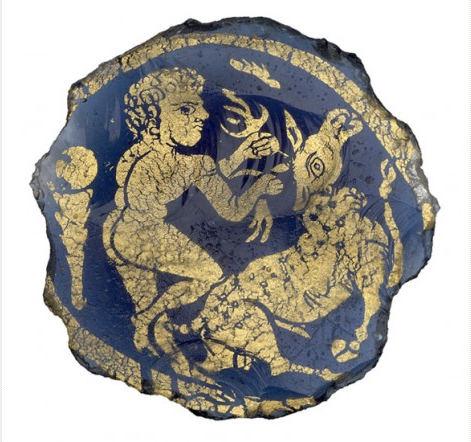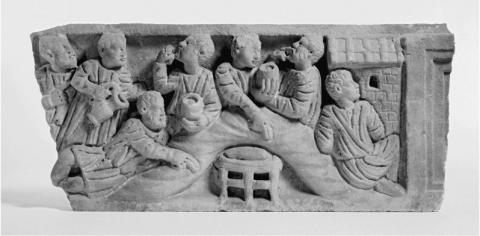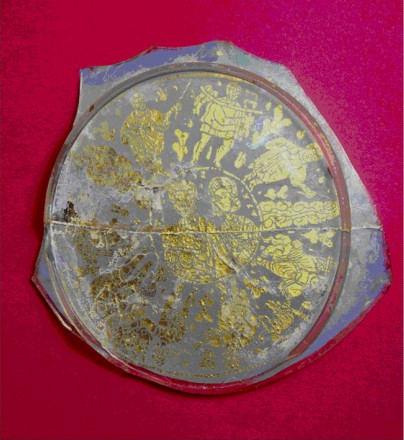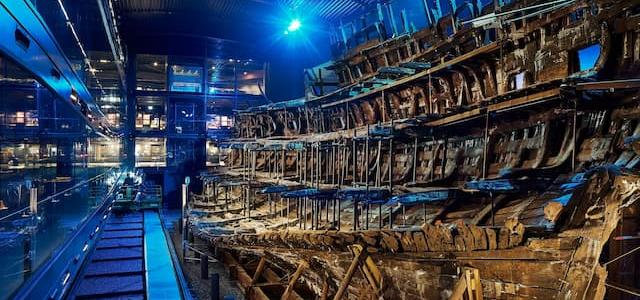
Roman Antiquities saved
Ashmolean Museum secures unique treasure trove of Late Roman gold glass and sculpture.



Today, the Ashmolean announces the successful acquisition of the Wilshere Collection – a stunning array of gold glass and sculpture - a significant addition to the Ashmolean’s collection of Antiquities. It provides evidence of early Christian and Jewish life in Rome and the use of artistic motifs and epigraphic practice. Moreover, it bridges a gap in the Museum’s collection illustrating key chapters in the history of glass-making and the art of Late Antiquity.
The Ashmolean bought the Collection for £250,000 from Pusey House, Oxford, with the generous help of the National Heritage Memorial Fund (NHMF), The Art Fund, the MLA/V&A Purchase Grant Fund, the Elias Ashmole Group, the Friends and Young Friends of the Ashmolean, and numerous private benefactors.
The thirty four glass shards form the most important element of the Collection. Previously decorating the tombs of Roman catacombs, the designs are made in gold leaf sandwiched between two layers of glass and are representative of a cross-section of iconographical themes. The finest piece is the base of a bowl illustrating a married couple surrounded by scenes of Christ’s miracles. Others depict the saints Peter and Luke and part of a Jewish menorah. Smaller roundels portray pagan subjects, such as the labours of Hercules, a lion’s head and a snake basking on rocks.
Among the twenty three sculptures and inscriptions, decorated sarcophagi feature the Christian themes of the Betrayal of Christ, the Entry into Jerusalem and the Feeding of the Five Thousand. Additional reliefs illustrate the Raising of Lazarus, Mary Magdalene, the Fiery Furnace and Jonah and the Whale. A significant group of inscriptions are conspicuously decorated with menorahs. These come from a Jewish catacomb discovered in 1857, one of six to have been used by the Jews of Ancient Rome.
Christopher Brown, Director of the Ashmolean, said “We are extremely grateful to the Governors of Pusey House and to the funding bodies for their contributions towards this remarkable collection, whose historical, social and spiritual importance will add enormous value to the Museum’s collections”.
Carole Souter, Director of the NHMF, said: “This unique collection offers wonderful clues about early Christian and Jewish life in Rome and we’re delighted this National Heritage Memorial Fund grant has helped ensure that future generations will be able to enjoy and learn from it.”
Charles Willes Wilshere (1814-1906), was a prominent member of the Oxford Movement and a student of ecclesiastical history and antiquities. Acquiring the collection during his travels to the continent, he bequeathed the glass along with the early Christian and Jewish sarcophagi and tombstones to Pusey House, Oxford. The glass fragments have been on loan to the Ashmolean since 1957 where they were prominently displayed, while the marble objects were lent to the Museum in 1984.
As part of the future display strategy planned for the Museum’s new building funded by the Heritage Lottery Fund, the Wilshere Collection will be united in one gallery devoted to The Mediterranean from Late Antiquity to Early Modern Times. The Collection will play a key role in the gallery’s narrative by providing an insight into the diverse social and religious practices of the time. The gold-glass fragments form the third largest assemblage of such material in the world, fulfilling the Ashmolean's mission to provide audiences with a centre for teaching and research.
Notes to Editors
National Heritage Memorial Fund (NHMF)
NHMF granted £100,000 for the acquisition of the Wilshere Collection. NHMF is the ‘fund of last resort’ for the nation’s heritage, coming to the rescue by funding emergency acquisitions in memory of those who gave their lives for this country. In recognition of the vital role it plays and to help meet an increasing number of applications, the Government doubled NHMF’s income from £5million to £10million for 2007-2008. Other acquisitions funded by NHMF include:
• An NHMF grant of £1.89million ensured that Turner’s The Blue Rigi, was secured and displayed in its natural home at the Tate.
• The rare and exquisite 2,000-year-old gold choker known as the Newark Torc was acquired for £350,000 by Newark & Sherwood District Council’s Museum Service, made possible by a £285,000 grant from NHMF.
• The Lakeland Arts Trust (LAT) was awarded a grant of £465,596 by NHMF to save a fascinating collection of boats of international importance. This collection, at the Windermere Steamboat Museum, is the most significant of its kind anywhere in the world.
The Art Fund granted £85,000 for the acquisition of the Wilshere Collection. As the UK’s leading independent art charity, it offers grants to help UK museums and galleries enrich their collections and campaigns widely on behalf of museums and their visitors. It is entirely funded from public donations and has 80,000 members. Since 1903 the charity has helped museums and galleries all over the UK secure 860,000 works of art for their collections. In 2006 it offered over £5 million to museums and galleries. In January 2007 The Art Fund successfully led the public appeal to save JMW Turner’s Blue Rigi for Tate. In April 2007 The Art Fund launched a new £5 million scheme – ‘Art Fund International’ – aimed at developing the collections of international contemporary art in UK regional museums and galleries. In July 2007 The Art Fund was instrumental in putting together a unique funding package to ensure Dumfries House in Ayrshire was secured for the nation. Independent of government, The Art Fund is uniquely placed to campaign on behalf of public collections across the UK. It was at the forefront of the campaign for free admission in 2001 and the campaign to save the Macclesfield Psalter in 2005.
The MLA/V&A Purchase Grant Fund is a government fund, established at the Victoria & Albert Museum (V&A) in 1881 as part of its nationwide work. 2006 marked the Fund’s 125th anniversary.
The annual grants budget, currently £1,000,000, is provided by the Museums, Libraries and Archives Council (MLA). The Fund supports the acquisition of objects relating to the arts, literature and history by regional museums, record offices and specialist libraries in England and Wales.
Each year it considers some 300 applications and in 2006-07 awarded grants to 115 organisations, enabling acquisitions of over £4million to go ahead.
Building a New Ashmolean
With the support of a £15million grant from the Heritage Lottery Fund (HLF), the Ashmolean is undergoing a major development to build on its strengths as a world-class museum of art and archaeology. The plan involves building thirty-nine new galleries, an education centre, conservation studios and a walkthrough between the Museum and the Cast Gallery. During the Ashmolean’s redevelopment, the Museum remains open to the public and business is taking place as usual. Visitors to the Museum can see most of the Western art galleries, the Print Room and the Egyptian galleries, as well as enjoying the temporary exhibitions, the Shop and the Café.
Admission Free, Opening Times: Tues- Sat: 10.00 – 5.00, Sun: 12.00 – 5.00, Bank Holiday Mondays: 10.00 – 5.00
Further information
Susie Gault
Phone: 01865 288298 Email: Susie.gault@ashmus.ox.ac.uk,
The Ashmolean, Beaumont Street, Oxford OX1 2PH
Dervish Mertcan or Alison Scott,NHMF press officers.

